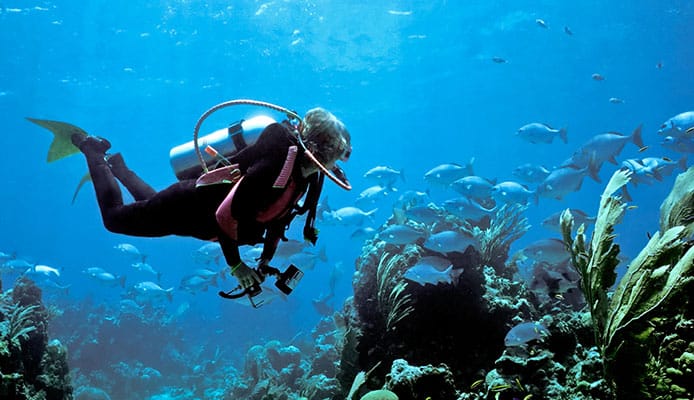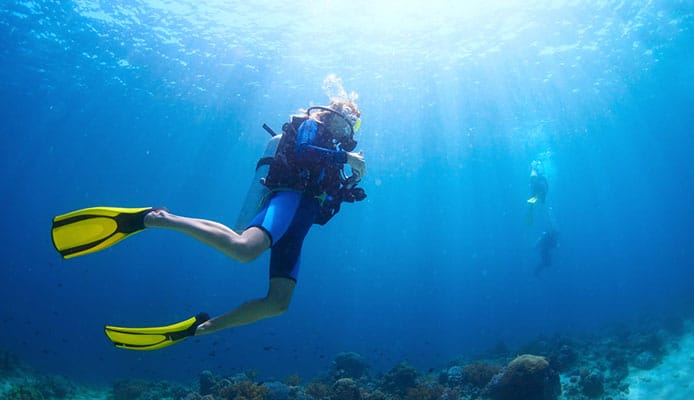
When most people hear the term “scuba” they immediately think about the practice of recreational or technical diving with a gas canister. Although this is true, the word scuba didn’t actually refer to the act of diving itself, which is generally referred to as diving. Instead, it was originally an acronym: SCUBA. So what does SCUBA stand for? It’s actually short for Self-Contained Underwater Breathing Apparatus. A simple google search about scuba meaning should reveal that much.
The device uses a two-stage regulator attached to a gas canister filled with air or enriched-air nitrox. These are then affixed to a vest which the diver puts on. The vest is called a buoyancy compensator (BCD) and has air bladders that allow divers to maintain neutral buoyancy within the water column.
But before there were gas canisters and regulators or even diving drysuits and diving wetsuits, people all over the world have been looking for different ways and means to allow them to explore what lies beneath oceans and lakes while still being able to breathe oxygen. Their creativity allowed them to invent a variety of underwater breathing apparatus, some of which were created centuries before the scuba diving gear as we know it came to light.
The Diving Bell
Before the diving suits and scuba tanks, divers use what was then known as a diving bell to allow them to breathe oxygen while underwater. These bells were shaped like, well, bells. They had a wide opening at the bottom and were sealed around the sides and at the top. And like bells of old, they were large and heavy.
The divers and the people assisting in the dive would lower the bell’s opening into the water so that air would be trapped inside of it. Then the divers would go underwater, and if they need air they would swim towards the bell and surface inside and breathe the trapped air. Divers would do this constantly while they explore underwater, returning to the bell from time to time for air.
Centuries later (the first records of the diving bell dates back to the 4th century BC) at around the 1600s, a newer version of the diving bell was invented which didn’t have any rope attachments like its predecessor. It was smaller, almost similar to a barrel in size and was covered in leather, and had windows to allow the diver to see in through. In this version of the diving bell, the diver stays inside the bell throughout the dive, as opposed to the older version where divers leave the bell after they’ve refilled their lungs with air.
Early Diving Suits
Because carrying a “barrel” of air while underwater didn’t make much of an appeal, diving suits were invented. The early diving suit was connected to the bell which served as their source of air while they walk or explore their surroundings.
By the 1700s, the first full-body diving suit was invented. It had a metal helmet (which looks nothing like today’s scuba mask), a metal girdle, and pants, and a vest made of waterproofed leather. It was attached to a pump turret which supplies air to the diver via a long, weighted tube.
During the 1800s, the “heavy footers” came into the picture. These were basically diving suits with thick waterproof leather, a metal helmet, and weighted boots to prevent divers from floating or drifting with the underwater current. Unlike today where divers move underwater by swimming and flapping their scuba fins, divers before had to walk on the ocean floor whenever they go exploring the water’s depths. With a better air supply and heavier (and more stable) footing, divers were better able to move freely underwater.
At the same time, another version of the diving suit was invented. It had small portholes and articulated limbs and weighed an astounding 800 pounds. This was considered to be a breakthrough since this was the first human-shaped atmospheric diving suit where the pressure inside the suit was the same as the pressure at the surface. This helped divers deal with issues that are usually connected with decompression.
First Self-contained Underwater Breathing Apparatus (SCUBA)
It was during that same century when the first self-contained underwater breathing apparatus (SCUBA) was invented. Accordingly, this was the brainchild of Henry Fleuss and was the first diving invention that made use of compressed oxygen.
The contraption was composed of a rubber mask was connected to a rubber airbag, copper oxygen tank, and a scrubber for removing carbon dioxide so that air exhaled by the diver could be re-breathed. Because of this invention, divers back then no longer needed to rely on surface-supplied or manually pumped air. However, there was still a problem with oxygen toxicity, which meant that a better version was still needed.
The Modern “Aqualung”
Later on, Jacques Cousteau also referred to as the father of SCUBA diving came up with the idea of an ‘aqualung’. Sometime in the 1940s, Jacques Cousteau and his partner Emilie Gagnan co-invented a demand valve system, which is the predecessor of the scuba regulator that we know today. Their invention provided divers with a supply of compressed air when they breathed. The invention allowed him and the people on his underwater research team to spend more time underwater.
The aqualung has come a long way since then. Advanced and better technologies allowed scientists and manufacturers to improve upon these scuba gear and equipment, and thus allow divers to go deeper into the water and stay there for longer. Needless to say, it has paved the way for many of the exciting ocean discoveries that we know today, from searching for sunken ships to discovering new marine flora and fauna and everything else in between. Truly, without these inventions, a large portion of the world’s oceans would remain uncharted territories to this day.
You might also like:Buoyancy In Salt And Fresh Water
Globo Surf Overview
Scuba diving has certainly opened up a whole new realm of wonder for early explorers of the underwater world. This of course wouldn’t be possible without the help of brilliant minds behind these creative inventions. Perhaps you may be interested in other aspects of diving and answering the questions what does scuba stand for or scuba meaning may seem of little significance for those who are not so keen about the sport, but the answers coupled with a little history can make for a nice conversation while traveling en route to your diving destination.
More Scuba Reviews:
- Dive Camera
- Dive Light
- Full Face Scuba Mask
- Dive Watches Under 200
- Dive Watch Under 1000
- Cesa Diving
- Spearfishing Techniques


